No.3  October 2006 October 2006 | ||
 |
Crop Prospects and Food Situation | |
|
Regional reviews
Harvesting of the 2006 winter crops has been completed, coarse grains (maize and sorghum) are presently being harvested in Egypt and harvesting of paddy is about to start. Aggregate wheat output for the subregion is provisionally estimated at 18.6 million tonnes, a significant recovery from the drought-reduced crop in 2005. Wheat output in Egypt, the largest producer in the subregion, is provisionally estimated at 8.3 million tonnes, well up from the to the five-year average of 7 million tonnes. The improvement is due to the combination of a modest increase in wheat plantings in 2006 with respect to 2005 and the normal to abundant rains that have benefited the crops throughout the season. In Morocco , the wheat crop doubled from last year’s poor level while barley output more than doubled to 2.5 million tonnes. 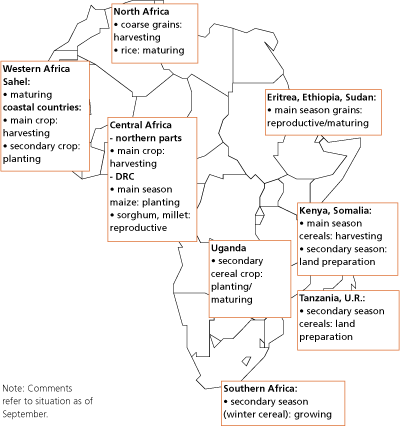
In the Sahel region, following below-normal rains in June/early-July in several parts, precipitation improved significantly in August over the main producing areas, increasing soil water reserves and providing relief to stressed crops, thus improving production prospects in most countries. However, in the areas affected by earlier dry conditions, some yield potential was already irrevocably lost and late plantings or replanted crops will still need more rains late in the season to cover their entire growing cycle and ensure a reasonable crop. In some areas where rains were particularly heavy severe flooding was reported, causing considerable human casualties and damage to crops, notably in Burkina Faso and Niger. From west to east, crop conditions are satisfactory in Cape Verde and Senegal following widespread rains in August . In The Gambia, according to remote sensing rainfall estimates, crop prospects appear to be mixed. Adequate rainfall favoured desalination and transplanting of swamp rice in Guinea-Bissau. In Mauritania, increased rains in August benefited crops in the south-west, but more good rains are needed in the south-centre and south-east. In Mali, Burkina Faso, Niger and Chad, crop conditions improved significantly after the scant rains of June. Satellite imagery for early September indicates that good rains continued to fall over most of the Sahel region. In the coastal countries of the Gulf of Guinea, rains have been regular and widespread since the beginning of the major season in April in the south, where harvesting of the first maize crop is underway. In the north, millet and sorghum crops are developing satisfactorily and harvest prospects are good, provided favourable weather conditions persist. However, migratory pests have reportedly destroyed about 50 000 tonnes of crops in central Nigeria in mid-September. Table 5. Africa cereal production (million tonnes)
Note:Totals computed from unrounded data.
In Cameroon and the Central African Republic, where rains have been abundant and widespread since the beginning of the cropping season in April, harvesting of the first 2006 maize crop is underway. In the latter country, however, agricultural recovery and food security continue to be hampered by persistent insecurity and inadequate availability of agricultural inputs, notably in northern parts.
Harvesting of the 2006 main season cereal crops has almost been concluded in southern parts of the subregion. In northern parts crops are at varying stages of development and abundant rains in July and August generally improved prospects. However, severe floods in some areas have resulted in loss of life and caused damage to crops and property. Over the last three years, successive poor rains in most pastoral areas of the subregion have severely affected pastures and livestock, resulting in acute food shortages and the migration of thousands of people in search of water and food. Past or ongoing civil conflicts have also seriously disrupted food production and distribution in some areas. Table 6. Sudan: Coarse Grains Production in Darfur 1996-2002( Avg.) 2003, 2004, 2005 (Area in 000 feddans and Production in 000 tonnes)
*One feddan is equivalent 0.42 ha.
1 Indicates a switch from millet to sorghum due to seed provision and good early rainfall. Total harvested area was only 4 percent
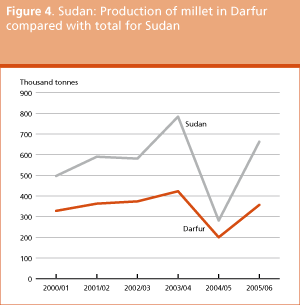
It is clear from the above that the bulk of the staple millet crop in Sudan is produced in Darfur and any disruption to the harvesting will have a significant negative impact. In southern Sudan, conflict arising from this year’s disarmament process and the ongoing cattle raiding in Jonglei continues to exacerbate food insecurity. Fighting disrupted wild food collection, fishing and traditional livestock/grain exchange mechanisms during the dry season (January to April), forcing households and cattle to return from dry season grazing areas earlier than normal. An interagency assessment led by the UN conducted in June found that food shortages have increased due to conflict. Local defence and security forces lost their food to looting, and this overburdened the community as they had to feed the forces at a time when food is most scarce. In addition, insufficient access to seeds and tools, reportedly caused by the conflict, affected the ability of households to take full advantage of this year's cropping season, despite an earlier than normal season onset and improved rains when compared to last year. The assessment also reported that heavy rains have affected maize and sorghum crops in some areas. Elsewhere in Sudan, extensive floods in parts have displaced tens of thousands of people, and destroyed crops and property. Although a respite is now reported, heavy rains in the Blue Nile catchment areas in the Ethiopian highlands caused an overflow of the Nile river, surpassing those of earlier years, and submerged many villages and settlements. An FAO/WFP Crop and Food Supply Assessment Mission is visiting southern Sudan in October and is planned to visit northern Sudan in November to assess the main season production and estimate food assistance requirements, if any, in 2007.
In Southern Africa, the final estimate of the aggregate 2006 maize harvest stands at 14.38 million tonnes, about 16 percent down from the output in 2005. Excluding South Africa, however, the subregion’s 2006 maize and total cereal harvests, estimated at 7.78 million tonnes and 12.89 million tonnes, respectively, represent historical record levels and are a significant improvement over the past year, in the magnitude of 46 percent for maize and 28 percent for total cereals. The total for all cereals includes an early forecast for the winter crops (mainly wheat) which amounts to about 12 percent of the total. Apart from the generally favourable weather conditions during the growing season, subsidized fertilizer distributions in some countries (for example in Malawi and Zambia) were also an important contributing factor to this outcome. The final official estimate in South Africa, puts the 2006 maize production at 6.6 million tonnes, sharply down from near record harvest of 11.72 million tonnes last year. The decline in production caused by a sharp drop in the area planted is the result of low prices at planting time coupled with high carryover stocks of maize (estimated at 4 million tonnes as of 30 April 2006). Thus, despite good crops elsewhere, the subregion’s aggregate 2006 coarse grain output is estimated by FAO at 15.8 million tonnes, about 14 percent down from 2005. While in most other countries in the subregion bumper harvests were gathered, in Angola, total cereal output, estimated at 749 000 tonnes, decreased by 16 percent due to erratic rains and long dry spells that particularly affected the central and south-western provinces. In Madagascar, maize production in the south was also reduced this year compared to 2005 due to dry weather. However, the output of paddy rice, by far the most important crop on the island, increased from the above-average level of 2005. Reflecting this year’s good crops in most countries, the aggregate cereal import requirement of the subregion for the 2006/07 marketing year (April/March in most cases) is now revised at 6.5 million tonnes, some 10 percent lower than in the previous year (See Figure 5). If South Africa is excluded, the reduction in the total cereal import requirements of the subregion is more pronounced, declining from the actual imports of 4.95 million tonnes in 2005/06 to an estimated requirement of 3.72 million tonnes in 2006/07. Food assistance needs in 2006/07 estimated at about 542 000 tonnes would be lower than the average annual food aid of the previous five years, calculated at about 708 000 tonnes. Table 7. Southern Africa – Import requirements for 2006/07 and estimated imports for 2001/02-2005/06 ( 000 tonnes)
Source: FAO/GIEWS
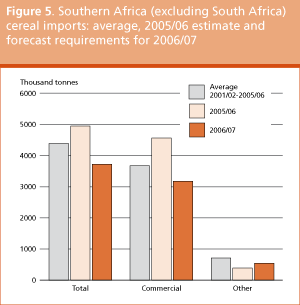
In the countries where production recovered, maize and other cereal prices have declined sharply since the beginning of the new harvest in April to normal post-harvest lows, resulting in an improvement in food security in general. As seen from Figure 6, maize prices in the capital city markets in Zambia and Mozambique, were about US$354 and US$390 per tonne, respectively, during the peak of the hunger season in February 2006, compared to the current levels of about US$172 and US$210. In South Africa, contrary to the usual post-harvest trend, the SAFEX price of white maize has been rising from a low of US$126 per tonne in September 2005 to the current level of US$187 per tonne, reflecting the huge levels of stocks earlier and the sharp reduction in production later in this period. However, the still comfortable level of carryover stocks and the improved harvests in the other countries of the subregion are likely to limit further increases in prices. Changes in the maize prices in local currencies in South Africa and Zambia, on the other hand, have been a little more pronounced as compared to the changes in US$ prices. For example, between September 2005 and September 2006, a rise in the Rand price in South Africa and a drop in Kwacha price in Zambia were more a result of the weakened Rand and strengthened Kwacha against the US$, respectively. The Mozambique Metical, however, with the exception of a temporary devaluation in November 2005, has been fairly stable against US$ during this 12 month period. 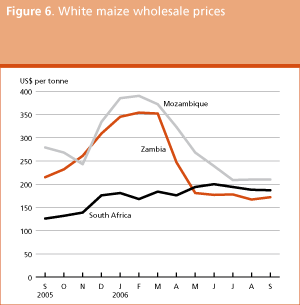
Overall, prospects for the regional food supply for the current marketing year look favourable. In South Africa, the subregion’s major exporter, supplies of white maize (for human consumption) are estimated at 6.3 million tonnes which, compared with a domestic utilization of 4.3 million tonnes, leaves a surplus of 2 million tonnes. Assuming the level of the strategic reserves at about 600 000 tonnes, the potential exportable surplus of white maize from South Africa is likely to be about 1.4 million tonnes, just enough to cover the needs of the other maize deficit countries in the subregion estimated at about 1.3 million tonnes. In addition, some sizeable exportable quantities are estimated from Malawi (200 000 to 350 000 tonnes), Zambia (180 000 to 280 000 tonnes) and Mozambique (150 000 to 250 000 tonnes) after accounting for a build-up of stocks in each of these three countries to a level of about 100 000 tonnes. AFRICA: Countries in crisis requiring external assistance and main reasons (26)
Harvesting of the main rice and maize crops, which make up the bulk of the subregion’s cereal crops, is underway in most countries. Following above-average precipitation throughout the season across most of the subregion, FAO forecasts the 2006 aggregate output of rice at 570.2 million tonnes, about 1 percent up from the good crop in previous year and 6 percent above the five-year average. A bigger crop expected in India, for the second successive year, accounts for most of the increase. The 2006 production of maize in this subregion is forecast at 192.1 million tonnes, 2 percent up from the previous year’s record harvest and 14.5 percent above the five-year average. The 2006 wheat output in the subregion, gathered earlier in the year, is estimated at a record level of 197.9 million tonnes. For both maize and wheat, the growth is expected largely in China. Table 8. Asia cereal production ( million tonnes)
Note: Totals computed from unrounded data.
In China (Mainland), the main rice crop is presently being harvested, while harvesting of the late crop will take place in October-November. The forecast for 2006 aggregate paddy production has been revised downward to 181.5 million tonnes from the previous estimate of 185 million tonnes to reflect the impact of serious drought in Sichuan, Chongqing and Heilongjiang. But this production is still close to last year’s high level. Harvesting of maize in southern areas was completed in August, but is still ongoing in northern China. Latest information points to a record output of 142 million tonnes, 2.6 million tonnes up from last year and 17.8 million tonnes above the five-year average, as a result of increased area and higher yield. In 2006/07, China’s cereal imports are expected to remain at the relatively low level of some 4 million tonnes, but cereal exports are forecast to decrease from some 7.5 million tonnes to 5.5 million tonnes. 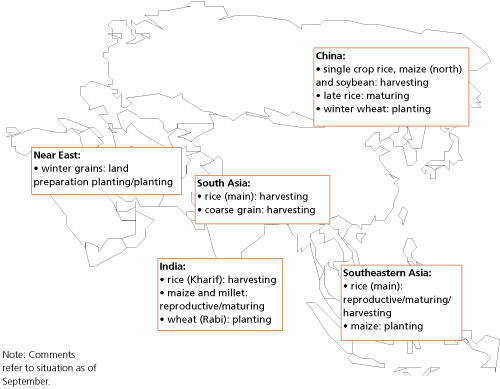
Despite an overall satisfactory food supply situation in the subregion, food shortages and emergencies persist, at national or subnational levels due to natural disasters and civil unrest. In DPR Korea, harvesting of the 2006 main season crops of rice, maize, and potatoes is underway. Lower output than last year is expected, as a result of severe floods that struck South Pyongan, North Hwanghae, Kangwon and South Hamgyong provinces in mid-July, which totally or partially destroyed 23 400 houses and left some 19 000 families homeless, and caused extensive damage to crops (mainly maize, paddy and soybeans). Total cereal import requirement in 2006/07 (Nov/Oct), including commercial import and food aid, is expected at more than 1 million tonnes. The food security situation of many urban residents in Timor-Leste remains significantly affected by recent civil unrest. By the end of August, WFP had provided a 1 467 tonnes of food assistance to approximately 167 100 beneficiaries.
Most countries in the Near East harvested average to above-average cereal crops this year reflecting favourable growing conditions. Jordan has registered increased production, continuing to recover output from the 2004 drought-affected poor crop. The food situation in the West Bank and Gaza Strip gives cause for serious concern due to shortages and market disruption, which are further aggravated by the current tense political situation. In Afghanistan reduced precipitation and drought conditions have almost entirely decimated rainfed cereals in northern and western parts of the country, while the associated impact on irrigation reserves has resulted in significantly reduced yields also of irrigated wheat. Severe food shortages and movement of people in search of food in some parts of the country have already been reported. The situation may further deteriorate with the onset of winter.
Cereal harvesting is virtually complete in the region and the aggregate output is estimated at just over 29 million tonnes, more than half a million tonnes up on 2005. The improved harvest is mainly due to above-average precipitation in the main producing parts of the subregion, especially snowfall during the winter, which amply replenished water reserves for the extensive irrigation systems. The aggregate harvest includes some 23.7 million tonnes of wheat and 4.8 million tonnes of coarse grains. Kazakhstan is the main producer in the region and accounts for about 50 percent of the total cereal output. Reflecting the good harvest, aggregate cereal exports from Kazakhstan during the 2006/07 marketing year are forecast to rise to about 4.7 million tonnes, some 769 000 tonnes up on 2005/06. Uzbekistan is also expected to export a significant volume in 2006/07, estimated at about 500 000 tonnes. The country switched from being a net importer of cereals only a few years ago, and since then has maintained a significant level of exports, ranging from 200 000 to 500 000 tonnes annually in the marketing years since 2003/04. However, while the 2006 output was satisfactory in the main producing parts of the subregion, other areas suffered localized crop losses due to dry spells during the season, notably in Armenia, which has led to a tight cereal supply situation (see box).
Armenia suffered reduced precipitation in 2006 spring/summer causing significant losses of the rainfed spring cereal crops, mainly barley, but also reduction in yields of the winter irrigated cereal crops, mainly wheat. Rainfall practically ceased between May and June, when cereal crops were in the grain development stage. Wheat, potatoes and fruit trees are the most important crops in Armenia. Spring cereals (barley and wheat) are mainly grown under rainfed conditions and output is normally around 100 000 tonnes or about 14 percent of the aggregate annual cereal harvest. Nearly 70 percent of the spring cereals is barley cultivated in the uplands for feeding livestock. Most households in the rural areas keep at least one cow for subsistence and limited livestock products are also sold. Pure pastoralists and intensive livestock farms, except very few Kurdish households in the uplands, do not exist in the country. However, the integrated crop-livestock system plays an important role in rural household food security, both through direct household nutrition supplement and as a source of income. Latest Government reports indicate that on average about 60 percent of the spring cereals have been compromised following reduced precipitation this summer. Winter cereal output dropped by about 14 percent compared with the harvest in 2005. In aggregate, the Government estimates the 2006 cereal output at about 304 000 tonnes, nearly 74 000 tonnes, or 20 percent, down on the 2005 harvest. The Government also reports that crop damage varies greatly across regions. In some areas more than 90 percent of the crops have been compromised, while in others the damage is estimated at about 10 – 15 percent. The second most important crop, potatoes, has reportedly fared well along with vegetables, which are cultivated under irrigated systems. In addition to losses in the 2006 barley crop, grazing areas have also been affected by the reduced precipitation in spring/summer. These factors have significantly reduced feed supply for livestock, which has reportedly prompted many farmers to sell their animals. The Government has requested international food and feed assistance. ASIA: Countries in crisis requiring external assistance and main reasons (9)
Harvesting of the 2006 main season cereal crops is about to start in Mexico but is virtually complete in the other Central American countries, where planting of the second season crops just started. The 2006 aggregate cereal output of the subregion is forecast by FAO at 38.2 million tonnes, about 2.7 million tonnes above the previous year’s level and 1.2 million tonnes below the average of the last five years. In Mexico, harvesting of the 2006 main rain-fed summer coarse grain crops, accounting for some 75 percent of the annual production, is expected to start from late October. Beneficial rains across the major producing southern and south central states of Jalisco, México and Chiapas have continued to provide adequate moisture and early official forecasts point to an above-average production. Maize and sorghum outputs are forecast at about 21.3 and 6.2 million tonnes respectively, with increases of 8 and 10 percent from the previous year’s levels as a consequence of an expansion in the areas planted. Land is being prepared for planting of the 2006/07 winter wheat crop in the irrigated areas of north-western states of Sonora, Guanajuato, Baja California, where heavy rains at the beginning of September have positively increased the water level of main reservoirs. 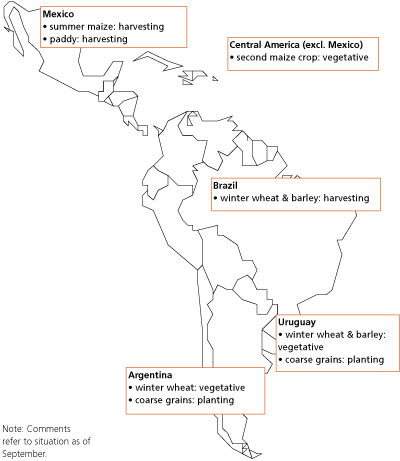
The 2006 aggregate (first and second season crops) maize outputs throughout the subregion are provisionally forecast at above-average levels. This is essentially due to the positive effects on the main season yields of the abundant rains that have been reported in most parts since the beginning of August. The only country where 2006 maize production is expected to be below the level of the previous year is Honduras as a consequence of a prolonged drought period (the so-called canicula) that affected some parts of central departments in August. In the Caribbean, in Haiti, the Dominican Republic and Cuba, the abundant rains due to the remote passage of some hurricanes have benefited yields of the main food and cash crops that were locally affected by recurring dry spells from March to May. In Guatemala and El Salvador, food assistance from the international community continues to be delivered to vulnerable rural families and communities affected by hurricanes during the second half of 2005. Food aid is also distributed to vulnerable population in Haiti, Nicaragua and Honduras. Table 9. Latin America and Caribbean cereal production
|
||||||||||||||||||||||||||||||||||||||||||||||||||||||||||||||||||||||||||||||||||||||||||||||||||||||||||||||||||||||||||||||||||||||||||||||||||||||||||||||||||||||||||||||||||||||||||||||||||||||||||||||||||||||||||||||||||||||||||||||||||||||||||||||||||||||||||||||||||||||||||||||||||||||||||||||||||||||||||||||||||||||||||||||||||||||||||||||||||||||||||||||||||||||||||||||||||||||||||||||||||||||||||||||||||||||||||||||||||||||||||||||||||||||||||||||||||||||||||||||||||||||||||||||||||||||||||||||||||||||||||||||||||||||||||||||||||||||||||||||||||||||||||||||||||||||||||||||||||||||||||||||||||||||||||||||||||||||||||||||||||||||||||||||||||||||||||||||||||||||||||||||||||||||||||||||||||||||||||||||||||||||||||||||||||||||||||||||||||||||||||||||||||||||||||||||||||||||||||||||||||||||||||||||||||||||||||||||||||||||||||||||||||||||||||||||||||||||||||||||||||||||||||||||||||||||||||||||||||||||||||||||||||||||||||||||||||||||||||||||||||||||||||||||||||||||||||||||||||||||
| Wheat | Coarse grains | Rice (paddy) | Total Cereals | |||||||||
| 2004 | 2005 estim. | 2006 f’cast | 2004 | 2005 estim. | 2006 f’cast | 2004 | 2005 estim. | 2006 f’cast | 2004 | 2005 estim. | 2006 f’cast | |
| Latin America & Caribbean | 27.7 | 23.7 | 22.0 | 108.3 | 102.9 | 106.1 | 25.6 | 26.3 | 25.0 | 161.6 | 152.9 | 153.1 |
| Central America & Caribbean | 2.4 | 3.0 | 3.2 | 33.5 | 30.2 | 32.5 | 2.3 | 2.3 | 2.5 | 38.2 | 35.5 | 38.2 |
| Mexico | 2.4 | 3.0 | 3.2 | 29.7 | 26.2 | 28.5 | 0.3 | 0.3 | 0.3 | 32.4 | 29.5 | 31.9 |
| South America | 25.3 | 20.7 | 18.9 | 74.8 | 72.8 | 73.6 | 23.3 | 24.1 | 22.4 | 123.4 | 117.5 | 114.9 |
| Argentina | 16.0 | 12.6 | 13.3 | 18.7 | 24.5 | 18.1 | 1.1 | 1.0 | 1.2 | 35.7 | 38.0 | 32.6 |
| Brazil | 5.8 | 4.7 | 2.7 | 44.9 | 37.5 | 44.5 | 12.8 | 13.2 | 11.6 | 63.5 | 55.4 | 58.8 |
| Colombia | - | - | - | 1.6 | 1.7 | 1.5 | 2.7 | 2.5 | 2.3 | 4.4 | 4.2 | 3.8 |
South America |
 |
Harvesting of the 2006 winter wheat crop has recently started in Centre-South states of Brazil, while it is expected to start by the end of October in the important growing areas of Argentina, Uruguay and Paraguay. Aggregate production for the subregion is tentatively forecast just below 19 million tonnes, the lowest level since 2002. This is essentially due to the record low expected in Brazil as a consequence of reduced plantings and yields. The area planted decreased sharply in response to low profitability of wheat in the past years, which has resulted in heavy indebtedness of farmers and lower use of fertilizers. Wheat yields have been negatively affected by dry weather conditions during the season in areas from northern Parana to Mato Grosso do Sul and Goias, as well as and by frosts at the beginning of September. Reduced soil moisture has also severely affected plantings of 2006 winter crop in Argentina, where the planned area of 5.9 million hectares was not achieved and the area planted is officially estimated slightly below 5.4 million hectares, only some 3 percent more than the previous year’s sharply reduced level. Low domestic prices and unfavourable weather conditions at planting are the key factors behind the reduced area under winter wheat in Chile and Paraguay.
Harvesting of the 2006 second season maize crop is virtually completed in the subregion and the 2006 aggregate production (first and second season) is estimated at an average 65.3 million tonnes, around last year’s level. This reflects a very good crop obtained in Brazil that compensated for reduced crops in Argentina and Uruguay due to a widespread reduction in planted area and lower yields following a mid-season dry spell. Meanwhile land is being prepared for planting the important 2007 summer maize crop in southern countries of the subregion. Prospects for planting are uncertain reflecting current dry conditions in parts.
Limited soil moisture is raising some concerns from the planting of the 2007 paddy crop that should start by mid-October. If substantial rains are not received during the next few weeks in the main growing areas, the area planted to the 2007 paddy crop may be further reduced from the low level of 2006, when low domestic prices in Brazil, the main producer in the subregion, induced a sharp decrease in plantings.
In Ecuador, parts of Los Ríos and Bolívar provinces have been severely affected by ash fall following the eruption of the Tungurahua volcano in mid-August, with serious long-term consequences for soil fertility. A preliminary assessment indicates that more than 100 000 persons have been directly affected by the disaster and that approximately one quarter of them is in immediate need of food assistance.
Dry weather conditions are affecting agriculture and livestock sectors in Argentina |
 |
A prolonged drought is severely affecting the agriculture and livestock sectors in Argentina. Precipitation has been scarce since late July in north and north-western provinces (Santiago del Estero, Chaco, north Santa Fe, Salta and Catamarca) and since the beginning of August in south-east and south-west Buenos Aires, La Pampa and centre-south Córdoba provinces. Light rains in the second decade of September in most parts of the country were insufficient to reverse the drought situation.
In the north-western provinces of Catamarca, San Juan and La Rioja it has been reported that about 40 000 head of cattle have been lost due to poor pasture conditions, while many others are being sold or moved into other provinces with better pasture availability in order to avoid further losses. In the main cereal growing central provinces, where planting of the 2006 wheat crop was still underway in August, the dry weather conditions have prevented farmers from achieving the planned acreage of 5.9 million hectares, in particular in the south-west of Buenos Aires province and in the centre-west of La Pampa province. The area planted to wheat is officially estimated at about 5.4 million hectares, only some 3 percent more than the record low of the previous year.
By late September, about 30 percent of the wheat crop was suffering from water stress and high temperatures, while just over half is reported to be in good or very good condition. The crop is due to be harvested from November and if substantial rains are not received soon, yields are likely to be reduced in several areas, mainly in the provinces of Córdoba, Santa Fe, Entre Ríos, Santiago del Estero, Chaco and north-west Buenos Aires.
Based on the current condition of crops, wheat output in 2006 is tentatively forecast to reach at best 13 million tonnes, similar to last year’s reduced crop and well below the good 2004 crop, of 16 million tonnes, and the average. However, should conditions worsen, the harvest could fall even lower.

The area that has not been planted to wheat is expected to be planted to 2007 summer crops, such as maize, sorghum and sunflower. However, the pace of planting, which normally starts in mid-September is very slow because of the exceptionally dry soils, and if precipitation does not resume in the next few weeks, the area planted to the 2007 coarse grains may substantially decrease. Weather concerns are also delaying planting of the 2007 paddy crop in the main growing provinces of Corrientes and Entre Ríos.
This situation will probably determine a shift in land use, where areas earmarked for summer coarse grain crops are turned over to soybean, which is planted somewhat later from November to January. In this case, the country’s capacity to export cereals and meat products in the 2006/07 marketing year would be reduced, while output of soybean could rise even further above the record output of 40.5 million tonnes obtained this year.
| Widespread lack of access | |
| Haiti | Insecurity, economic crisis |
| Severe localized food insecurity | |
| Colombia | Conflict, IDPs |
| Ecuador | Volcanic eruption |
| Note: For explanation see terminology. | |
North America, Europe and Oceania |
 |
North America |
 |
Planting of the United States’ winter wheat crop for harvest in 2007 was reported to be about 36 percent complete as of late September. This was marginally behind the average pace as fieldwork had been hampered during the month in some areas by wet fields, and in others by excessive dryness. However, the situation was expected to improve with the arrival of beneficial rains in some previously dry southern parts at the end of the month. Early indications point to a significant expansion in the wheat area. The 2006 wheat crop, harvesting of which was virtually complete by the end of August, is officially estimated at about 49 million tonnes, 14 percent below the 2005 crop and well below the average of the past five years. An overall increase in plantings was more than offset by a sharp drop in yields following drought during a large part of the 2005/06 season. With regard to coarse grains, as of late September, harvesting of maize was reported to be about 13 percent complete, just slightly behind the average pace. The area for harvest is estimated to be about 4 percent down from the previous year but better yields are expected, and output is forecast up marginally on last year’s at 282.3 million tonnes, which would be the second largest crop on record after 2004. Crop conditions and yield prospects improved across the northern Great Plains and the western Corn Belt in August following favourable rainfall. Output of other coarse grains is expected to decrease in 2006 after planted areas were reduced and also because smaller yields are forecast.
In Canada, the harvest of the bulk of the wheat in the main producing western regions is virtually complete. Latest official estimates put the total wheat output at 25.9 million tonnes, about 3 percent down from last year’s bumper crop but still well above the average of the past five years. The reduction is due to sharp declines in both area and yield of durum wheat, which more than offset an increase in production of other wheat. This year’s coarse grains area is estimated to be down marginally from the previous year along with a significant switch to more oats and less barley. With yields expected to return closer to average (as was the case for wheat) the aggregate coarse grain output is forecast at some 23.8 million tonnes, 9 percent down from last year.
| Wheat | Coarse grains | Rice (paddy) | Total Cereals | |||||||||
| 2004 | 2005 estim. | 2006 f’cast | 2004 | 2005 estim. | 2006 f’cast | 2004 | 2005 estim. | 2006 f’cast | 2004 | 2005 estim. | 2006 f’cast | |
| NorthAmerica | 84.6 | 84.1 | 75.0 | 346.6 | 325.4 | 319.9 | 10.5 | 10.1 | 8.8 | 441.7 | 419.6 | 403.6 |
| Canada | 25.9 | 26.8 | 25.9 | 26.7 | 26.3 | 23.8 | - | - | - | 52.6 | 53.0 | 49.7 |
| United States | 58.7 | 57.3 | 49.0 | 319.9 | 299.1 | 296.1 | 10.5 | 10.1 | 8.8 | 389.1 | 366.5 | 353.9 |
| Europe | 219.5 | 207.3 | 188.5 | 245.4 | 213.6 | 213.2 | 3.4 | 3.4 | 3.3 | 468.4 | 424.3 | 405.1 |
| EU | 137.5 | 123.7 | 119.1 | 152.1 | 133.5 | 131.8 | 2.8 | 2.7 | 2.6 | 292.5 | 259.9 | 253.4 |
| Romania | 7.8 | 7.3 | 5.3 | 16.8 | 11.5 | 11.5 | - | - | - | 24.5 | 18.9 | 16.8 |
| Serbiao | 2.8 | 2.0 | 1.9 | 7.1 | 7.5 | 6.2 | - | - | - | 9.9 | 9.5 | 8.1 |
| CIS in Europe | 64.8 | 68.5 | 57.0 | 60.3 | 53.4 | 56.2 | 0.6 | 0.7 | 0.7 | 125.6 | 122.5 | 113.9 |
| Russian Federation | 45.4 | 47.7 | 41.5 | 30.3 | 28.3 | 29.2 | 0.5 | 0.6 | 0.6 | 76.2 | 76.5 | 71.3 |
| Ukraine | 17.5 | 18.7 | 13.7 | 23.1 | 18.6 | 20.7 | 0.1 | 0.1 | 0.1 | 40.7 | 37.4 | 34.5 |
| Oceania | 22.2 | 25.4 | 16.7 | 12.7 | 15.0 | 10.6 | 0.6 | 0.3 | 1.1 | 35.4 | 40.8 | 28.4 |
| Australia | 21.9 | 25.1 | 16.4 | 12.1 | 14.5 | 10.0 | 0.5 | 0.3 | 1.0 | 34.6 | 39.9 | 27.4 |
Europe |
 |
The 2006 cereal harvest in the EU has turned out considerably smaller than earlier expected after exceptionally hot and dry weather in July adversely affected crops in several countries. It is reported that the geographic area affected this year by yield loss related to the hot and dry conditions has been larger than in the severe drought year of 2003. However, because the period of water scarcity was shorter, the yield reduction has been less pronounced than in 2003. The aggregate cereal output of the EU is now estimated at 253 million tonnes, 7 million tonnes less than last year and about 3 percent below the average of the past five years. Among the major producers, the largest yield losses compared to last year were recorded in Hungary, Poland, Italy, Germany and France, and in the latter four countries, the average yields were also well down on the five-year average. By contrast, in Spain, output recovered sharply from the very poor drought-reduced level last year, although remaining somewhat below the average. By cereal type, the largest output reductions have been recorded so far for wheat and rye, while the maize harvest, still to be completed, is also expected to be well down on last year. Planting of the winter cereals for harvest in 2007 is reported to be proceeding well under generally favourable conditions.
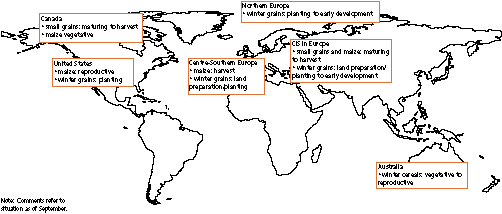
The Balkan Peninsula escaped the severe summer drought that affected the north and west of the region, but this year’s cereal output is nevertheless expected to be down from 2005. The decrease is largely due to smaller wheat crops in the two main producers – Romania and Bulgaria – where winter planting was reduced and, subsequently, severe winter conditions and flooding damaged and/or destroyed some large areas of crops, particularly in the former country. Prospects for the maize harvest, which has still to be completed, are more favourable, and output is expected to remain at last year’s about-average level.
In the European CIS (the Russian Federation, Ukraine, Belarus and Moldova), cereal harvesting is almost complete and the aggregate output of the four countries this year is estimated at about 114 million tonnes compared with 122.5 million tonnes in 2005. Severely cold weather and relatively thin snow cover last winter were the main reasons for the decline in harvest. Wheat was the main crop affected by the harsh winter, with output falling in the Russian Federation and Ukraine by about 13 percent and 27 percent respectively, bringing the aggregate crop for the region down to an estimated 57 million tonnes, some 11.5 million tonnes below the 2005 harvest. The winter coarse grains are more resistant to harsh weather and, with the bulk of the crop now harvested, the aggregate output in the region is forecast at some 56 million tonnes, about 2.8 million tonnes up on the harvest in 2005. The aggregate cereal exports from the region during the 2006/07 marketing year are forecast at about 18.4 million tonnes, some 6.7 million tonnes down on the 2005/06 marketing year. Of the total, wheat is expected to account for about 9.6 million tonnes, while coarse grains (mainly barley) would account for about 8.8 million tonnes. Aggregate cereal imports to the region during the 2006/07 marketing year are forecast at about 2.6 million tonnes, similar to the volume imported in the previous year. Land preparation for the winter grain planting is reported to be progressing well under generally favourable conditions, and early tentative indications point to larger areas than in the previous year.
| Severe localised food insecurity | |
| Russian Federation (Chechnya) | Conflict |
| Note: For explanation see terminology. | |
Oceania |
 |
With the season in Australia progressing towards the start of harvest (about November in most parts), earlier predications of a drier than average winter cropping season in 2006 have materialized. Throughout most cropping regions crops have been stressed by lack of moisture, and in some parts this has been compounded by particularly hot temperatures. The latest official forecast for winter grain production released in the ABARE September Crop Report, has been revised downward sharply. Output of wheat in 2006 is now forecast at just 16.4 million tonnes, 35 percent down from last year and well below the five-year average. Output of barley is seen to fall by 41 percent to just 5.8 million tonnes. Early prospects for the summer cereals to be planted in the coming weeks are somewhat mixed. The sorghum area could be maintained about the level of last year as plenty fallow land is available in summer crop areas because of reduced winter plantings. However, good spring rains will be vital to allow planting to proceed and for crop establishment. The rice area is expected to decrease sharply in response to the reduced availability of irrigation supplies available after the dry winter.
| GIEWS | global information and early warning system on food and agriculture |